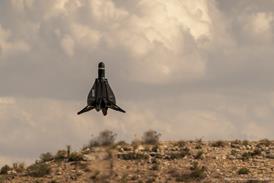Boeing's 737 Avionics Flying Laboratory (AFL) has entered the final flight test phase for its Joint Strike Fighter avionics integration work equipped with a production representative radar.
The final phase, which is expected to conclude at the end of next month after about 20 test flights and 20 demonstration sorties, will focus on matching the Raytheon synthetic aperture radar (SAR) to the targeting forward-looking infrared (TFLIR) and BAE Systems- helmet-mounted display. The work will include correlation of target symbology, as well as general integration tasks.
The AFL has flown more than 50 missions since its first flight last December and has amassed 115 flight hours. It is being used to demonstrate risk reduction of the JSF avionics system before any hardware is mounted in the actual aircraft.
The X-32A/B concept demonstrator aircraft do not have mission avionics and the suite being tested in the AFL will be used in the Preferred Weapons System Concept-configured aircraft should Boeing win the JSF competition in next year.
The aircraft's main role has been to demonstrate "multi-sensor fusion", in which inputs from on-board sensors (the SAR, TFLIR and electronic warfare) are fused with off-board data - from airborne warning and control systems, for instance - and processed by automated target-cueing software. The fused data is presented to the pilot in a representative JSF cockpit inside the 737's fuselage.
Boeing says the 11-day changeover to the new Raytheon-built radar, which is up to 70kg (150lb) lighter than the first radar tested, demonstrates the adaptability of its open-architecture avionics system.

Meanwhile, Boeing has installed a flight-standard propulsion system in the X-32B short take-off and vertical landing (STOVL) demonstrator. The propulsion system includes a Pratt & Whitney JSF119-614 engine and a Rolls-Royce-developed vertical lift and attitude control system. First flight for the STOVL X-32B is planned for late this year.
Source: Flight International























